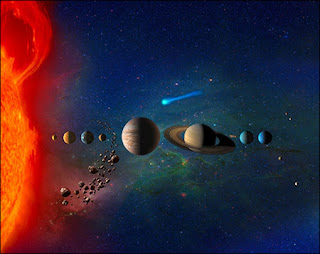- 2061
- Our Solar System
- How was it created? It all started with
a cloud of dust and gas coalescing around the Sun some 5 billion years
ago. After the rocky planets formed
there was a 300 million year bombardment of asteroids that brought water back
to Earth. Of the 3,700 planets
discovered most are more than 17 Earth masses, about the size of Neptune. Most are gas planets that orbit close to
their stars.
-
- TO
LEARN MORE, CLICK ON ADDRESS BELOW:
FEEDBACK ENCOURAGED
-
-
-
----------------------------- 2061 -
Our Solar System - How was it created?
-
-
It all started with a cloud of dust and gas coalescing around the Sun
some 5 billion years ago. Substances near
the Sun were vaporized, water and ice turned into gas leaving the cores that
were the rocky planets behind. Vaporized
water formed into ice further out from the Sun where the gas giant planets
formed.
-
-
After the rocky planets formed there was a 300 million year bombardment
of asteroids that brought water back to Earth.
This same bombardment pockmarked the face of Mercury , the Moon , and many
other airless objects. This bombardment
ended some 3,800 million years ago, although some asteroids are still entering
the inner solar system. One in particular
66 million years ago impacted Earth and killed off the dinosaurs that were
living here.
-
-
During the early planet formations planets likely bounced around like
billiard balls before settling into their current circular orbits. Our particular Solar System seems
unique. When the Kepler telescope was
launched in 2009 there were only a hundred exoplanets discovered. Now there are thousands of exoplanets being
studied.
-
-
Most of these exoplanets are 1 to 10 times Earth's radius and are close
to their stars having orbit periods of 120 days or less. Of the 3,700 planets discovered most are more
than 17 Earth masses, about the size of Neptune. Most discoveries are gas planets orbiting
close to their stars.
-
- The
first exoplanet discovery in 1995 was Pegasi b.
It is half Jupiter mass orbiting only 4,800,000 miles from its star
taking only 4.2 days. The planet Mercury
takes 88 days and is 29,000,000 from the Sun.
-
-
There is a bias in planet finding that must be recognized. We will tend to find planets with short
periods and with high masses. An alien
astronomer observing our solar system would have to wait 24 years to see two
Jupiter orbits.
-
-
How to explain our solar system?
The existence of Pluto in the orbit we see means it had to somehow be
pushed into that place. The Dwarf
Planet Ceres did not form where it is either?
This evidence points to planets migrating in order to get to their current
orbits.
-
-
Computer models have Jupiter forming first followed by Saturn then
Uranus and Neptune. Jupiter started only
3.5 AU from the Sun (one AU is today's
Earth-Sun distance, 93,000,000 miles).
The large tail of material in its orbit slowed Jupiter's momentum. Saturn formed at 4.5 AU. Jupiter migrated inward until it reached 1.5
AU. There Jupiter and Saturn reached a
mean motion resonance. Saturn making 2
orbits for every 3 Jupiter orbits. This
resonance created a braking effect.
-
-
The material orbiting inside Jupiter's orbit created an outward force
causing the giant planets to move outward.
The remaining plantesimals formed a ring around the Sun where the four
inner planets are today. As Jupiter and
Saturn tacked outward they captured Uranus and Neptune in resonance as
well. Uranus and Neptune exchanged
enough angular momentum for them to switch places with the Kuiper Belt of
asteroids. This also had the effect of
sending some asteroids inward toward the Sun and the rocky planets.
-
-
Is there another planet beyond the Kuiper Belt? In 2003 the Dwarf Planet Sedna was discovered
with an elongated orbit. Sedna is 600
miles diameter and 76 AU from the Sun. Five other objects have been found since
with similar orbits. Is his an indication that there is a Planet Nine outside
these orbits and yet to be discovered?
-
-
Our Solar System appears to be rare compared to exoplanets systems
discovered do far. But, just because our
solar system is hard to model mathematically doesn't mean that it can't
happen. Any general pattern needs some
exceptions. Maybe we are just the
exception? God only knows.
-
----------------------------------------------------------------------------------------
----- Comments appreciated and Pass it on to
whomever is interested. ----
---
Some reviews are at:
--------------
http://jdetrick.blogspot.com -----
--
email feedback, corrections, request for copies or Index of all reviews
------------------------- Monday, April 16, 2018
--------------------------------
-----------------------------------------------------------------------------------------

No comments:
Post a Comment